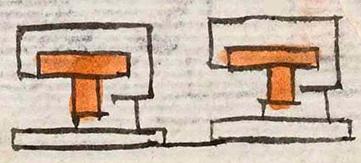imati (Mdz10r)
This simplex glyph for the place name Calimayan here doubles for the verb imati, to be prudent or orderly. In this case the reference is to two buildings in a row, facing the same direction (to the viewer's left). These are typical houses (calli) in profile, white, rectangular, and with the terracotta t-shaped doorways. The houses are facing toward the viewer's left. The locative suffix -yan, which always combines with a verb and means that something is done customarily, is not shown visually.
Stephanie Wood
What is important here is to note that the houses have a line connecting them, they face the same direction, and they appear to be in a row. See Daniel Brinton's translation of imati in the entry for the verb in our online Nahuatl Dictionary. Berdan and Anawalt (The Codex Mendoza, 1992, v. 1, p. 175) also support this reading.
It is tempting to see the "Imayan" as a possessed noun, such as maítl (hand, arm; perhaps building extensions), plus a locative. But, the locative suffix -yan is one that attaches to verbs and indicates customary action. (See Karttunen's discussion of Calli Imayan, in the entry to that place name..)
Stephanie Wood
cali ymayan. puo
Calli Imayan, pueblo (Calimaya, today)
Stephanie Wood
c. 1541, but by 1553 at the latest
order, arrangements, houses, buildings, architecture, casas, edificios, arquitectura, orden, arreglos

imati, to be prudent, https://nahuatl.wired-humanities.org/content/imati
Codex Mendoza, folio 10 recto, https://digital.bodleian.ox.ac.uk/objects/2fea788e-2aa2-4f08-b6d9-648c00..., image 30 of 188.
The Bodleian Libraries, University of Oxford, hold the original manuscript, the MS. Arch. Selden. A. 1. This image is published here under the UK Creative Commons, “Attribution-NonCommercial-ShareAlike 3.0 License” (CC-BY-NC-SA 3.0).

